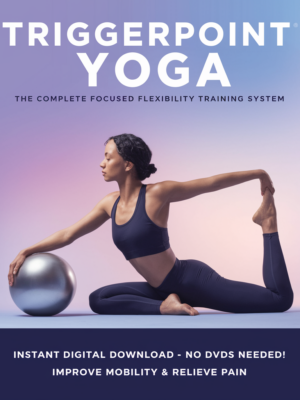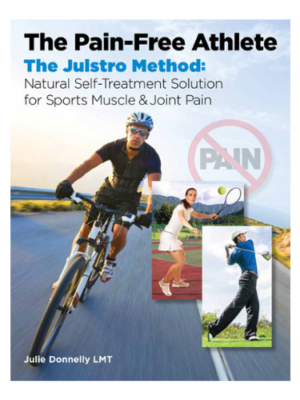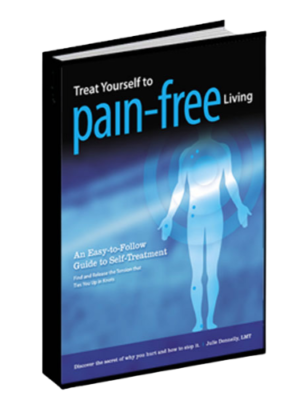Shoulder Pain Relief
Turning Loss of Shoulder Movement Into Total Shoulder Pain Relief
- Shoulder pain
- Frozen shoulder
Shoulder muscle and joint pain can be caused by stressful repetitive activities, including, among others, heavy lifting activities, housework, gardening, assembly line work, and sports such as skiing, golf, tennis and swimming. The Julstro Method, with its clinically-based self-treatment techniques and tools, effectively relieves these conditions. Using a Julstro Total Treatment System, shoulder pain sufferers can quickly treat themselves and return to normal activities and the sports they love.
What Causes Sharp Shoulder Pain and Loss of Shoulder Movement
Your shoulder is the most complex joint in your body. In order to do the multiple movements it is capable of performing, your shoulder has more muscles attached to it than any other joint.
A very painful condition called Frozen Shoulder occurs when several muscles go into spasm at the same time. The severity of the condition is caused by the number of muscles involved, and the intensity of the contractions. It can range from a mild ache with minor loss of range-of-motion, to severe and debilitating shooting pain and total loss of the use of the shoulder as it locks in place. This condition can be totally healed.
Every treatment Julie Donnelly teaches for the shoulder in any of her books or DVDs comes from her personal experience with Frozen Shoulder. She was forced to look at shoulder pain relief with new eyes, and then work out the self-treatments that would give her back her arm. At this point, Julie’s arm is 100% healed, even though it took her almost eight months to work out each treatment that enabled her to regain that mobility.
Due to the large number of muscles involved in this condition, and any shoulder pain, only the largest muscles will be covered here. While not a complete list, the primary muscles involved in shoulder pain are:
Shoulder Pain Source #1: Infraspinatus
The Infraspinatus draws your arm back. When there are spasms you will experience shoulder pain as you try to bring your arm forward.
Shoulder Pain Source #2:
When your arm is up, such as when you are putting something into the top of a closet or painting the ceiling, your Latissimus Dorsi muscle brings it back down to your side. When the muscle has spasms in it you will have shoulder pain as you try to lift your arm up.
Shoulder Pain Source #3: Teres Minor / Teres Major
The Teres Minor and Teres Major muscles are a key factor in frozen shoulder pain because they are responsible for bringing your arm across your body. When they are tight you will have pain if you try to turn your hand/arm out, for example, to reach over and open your car door, clap for a wonderful performer, or take a golf or tennis swing.
Shoulder Pain Source #4: Pectoralis Minor
Your Pectoralis Minor muscle curls your shoulder forward. When the muscle is tight you will look like you have poor posture and a rounded back. Your shoulder will hurt if you try to reach back behind you. Also, the muscle inserts into a bone in your shoulder that crosses over the nerves to your hand, so when the muscle is tight you may also have tingling in your hand and fingers.
Shoulder Pain Source #5: Pectoralis Major
The Pectoralis Major muscle rotates your upper arm in toward your body, so tension in the muscle will cause shoulder pain if your try to rotate your arm out and away from your body.
Shoulder Pain Source #6: Biceps
The Biceps muscle has two heads, one on the inside of your shoulder joint, and the other on a tiny bone called the coracoid process. When the Biceps have a spasm you may have pain deep within your shoulder, or since the coracoid process is directly over the nerves to your hand and wrist, you could have tingling in your hand (the common symptoms for carpal tunnel syndrome.
Shoulder Pain Source #7: Triceps
The Triceps are a three-part muscle that is located at the back of the upper arm and originates on the posterior/top of the arm bone (humerus) and also on the outer portion of the shoulder blade. Their common insertion point is just below the point of the elbow. When the triceps muscle contracts, you open your arm from the bent position. Tension, or trigger points, in the triceps causes pain across the entire back of your shoulder, upper arm and down into the elbow.
Shoulder Pain Relief – Once and For All
To treat and relieve shoulder pain, you often have to treat muscles that are nowhere near the shoulder. Julie Donnelly, creator of the Julstro™ Method, helps you find and release spasms in the correct muscles. There are also simple stretches you can do to prevent future pain.
The Julstro™ System shows you how to self-treat your shoulder pain by releasing spasms and lengthening muscle fibers. Using quick, simple treatments, you can relieve the symptoms of sharp shoulder pain, frozen shoulder, and loss of motion—and prevent their return.
That’s it! There’s no more waiting for a therapist or doctor’s appointment to relieve the pain. You are your best therapist. With the Julstro™ System, you may never need to spend another dollar on expensive therapy or questionable treatments.
- Could muscles really be causing your shoulder pain problems? YES!
- Can you really learn how to do the treatments to yourself? YES!
Stories
What People Are Saying About Julstro’s Shoulder Pain Relief Method
Shoulder pain &/or strain is a common injury, especially for athletes. Since 1989, Julie has treated hundreds of people with shoulder issues. Each client is treated as an individual, there is no “one-size treatment fits all.” Whether you see Julie in person or via a Zoom consultation, or if you self-treat using one of her books or self-treatment programs, you will find the answers that will give you continued pain relief.
Lest's Talk
Lorem ipsum dolor sit amet, consectetur adipiscing elit, sed do eiusmod tempor incididunt ut labore et dolore magna aliqua. Ut enim ad minim veniam, quis nostrud exercitation ullamco laboris nisi ut aliquip ex ea commodo consequat.
Related Products
-
Focused Flexibility Kit
The Complete Focused Flexibility Training System – TriggerPoint Yoga (MP4 Digital Download)
$67.00 Add to cartRated 0 out of 5



